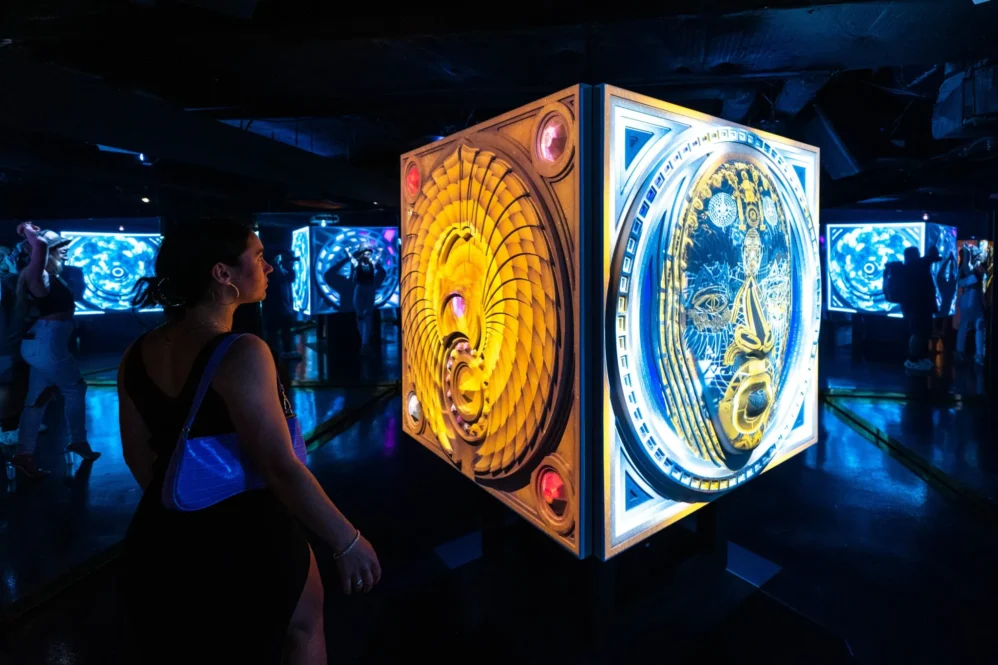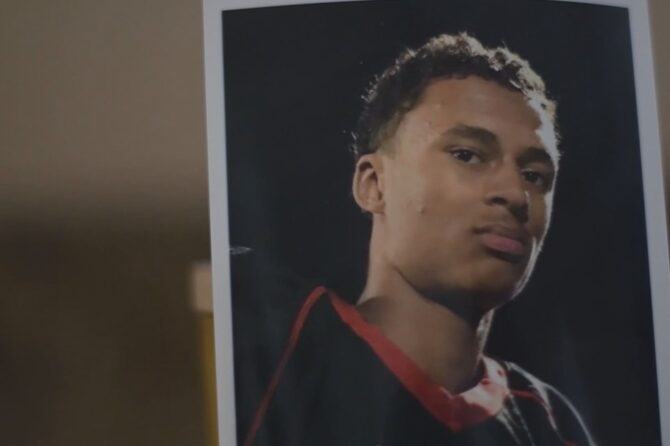Nestled between a fancy hotel, a Starbucks, and the Social Security Administration building sits another world entirely—one where ten-foot-tall African masks glide past floating buildings, and the silhouettes of goddess-like Black women drift on a psychedelic sky. ARTECHOUSE, an immersive, interactive art space near the Mall, opened Asë: Afro Frequencies to the public June 13. The exhibit, which features visuals by London-based Afrosurrealist artist Vince Fraser and audio by poet Ursula Rucker, celebrates Black triumph and the experience of the African diaspora.
“Our victory is not a mystery!” Rucker told a crowd of more than 75 listeners at an artists’ panel held in the space, echoing a line from her poetry. “Black people—tell your story!”
The panel discussion took place inside the main gallery, where projections move across the walls and the ground often appears to shift beneath one’s feet. Rucker shared the floor with Fraser, who sported his signature look with a full face covering and dark sunglasses, and Sheldon Scott, an artist and Global Head of Purpose at Eaton Workshop. Ngaire Blankenberg, Director of Smithsonian’s National Museum of African Art, moderated the panel; all proceeds from the evening’s ticket sales went to the museum.
“It’s meaningful for us, it’s powerful for us, and it’s mission-driven,” ARTECHOUSEs founder and Chief Creative Officer, Sandro Kereselidze, said. “We inspire, educate, and empower the next generation of artists—hopefully, more Black artists in this field—who can step up and be like, ‘hey, ARTECHOUSE, I want to create something like this, can you help?’ And we can.”
Fraser started talking with Kereselidze and his team about a collaboration more than three years ago. Asë first debuted last summer at ARTECHOUSE’s Miami location and then spent five months on display at the Bellagio Gallery of Fine Art in Las Vegas. But the ARTECHOUSE gallery in DC (which was the first location to open—Kereselidze has lived here in Washington since 1994) is significantly larger than the other spaces. All of Fraser’s artwork had to be digitally reconstructed to fill the 15,000-square-foot gallery. “It was absolutely breath-taking,” Fraser said of walking into the DC exhibit for the first time. “[I was] just gobsmacked to see it on such a big scale.”
Visitors, who had the chance to explore the exhibit after the panel discussion ended, seemed similarly impressed with the artwork. For more than an hour, people sat on the floor watching the projections in the main gallery and wandered through the other four, smaller galleries.
“We’ve had a lot of beautiful exhibits, a lot of pretty exhibits, a lot of interesting or fun exhibits—but not all of our exhibits are art on this level,” said Thiago Linck, an ARTECHOUSE host who has experienced four different ARTECHOUSE projects so far while working there. “You can feel the amount of passion and dedication and energy that goes into each and every part of this.”
The artwork on display includes interactive and immersive pieces, such as a fully mirrored room full of shifting wheels of light in bright colors; motion-sensor-operated maps of Africa projected onto the floor, which shift and spin under visitors’ feet; and a series of digital, futuristic-looking African masks that visitors can virtually try on.
Fraser focuses on African masks in a lot of his work. This gallery features designs inspired by rulers from the Ethiopian and Mali empires, traditional voodoo guardian symbols of the Ogu people, and helmet-shaped masks from the Yoruba people, among others. (Many of the artworks’ titles draw from the Yoruba language, too; Asë, pronounced ah-shay, is a philosophical belief held by the Yoruba people of West Africa, that invokes power to produce change.)
During the artist panel, Fraser spoke about what the masks symbolize in his work, and his remarks resonated with audience members. “The part that stood out to me [from Fraser’s commentary] is how we have found a safe space as Black people behind our masks—the masks that we have to wear to show up in White capitalist society,” Nina Brewton, a DC-based artist, benefit auctioneer and fundraising consultant, said. “So it’s giving new space to the idea of having a safe space. Instead of hiding behind the mask, now we are stepping forth and empowering each other and ourselves with the masks that are worn from our ancestors and the ones that will be worn in the future.”
Most of the audience for the artist panel was Black, and Quentin Williams—a Black spoken word artist and media company owner from Philadelphia, who came to DC to see the exhibit after being invited by Rucker herself—said that he was also excited by the diversity present at previous nights’ showings. “I saw White people, Indian people, Latinx, I saw Asian American people, and Black people. And it was really interesting to see everyone engaged with the art,” Williams said. “It seemed like everyone was just as enthusiastic about it. And I really appreciate that as a Black American, that people can appreciate Black history and Black art and Black perspectives—and enjoy drinks at the same time, and enjoy their own personal experience in the space, and not feel othered, to feel incorporated in it and seen in it. Because it helps integrate our experience as Americans.”
The exhibit touches on modern-day social justice issues alongside the stories of historic African kings and queens. The words “Black Lives Matter” break through a tangle of gold chains in one part of the main gallery’s immersive video, and protesters holding signs are shown marching down futuristic streets. Mostly though, the exhibit focuses not on persecution, but on celebration of the global Black experience.
“Growing up in the public school system, African American history was often painted to be very negative. And while that is part, at least in America, of the lived experiences of enslaved people, we didn’t start there,” Williams said. “To see the joy, to see African features, in a really positive and beautiful light, and to see black figures dancing, and to hear the drums and know that it’s upbeat, makes it more festive. And really my lived experience as a Black person is more joyful. Of course there’s ups and downs, but I feel like this is the party that I’ve been missing all my life.”
Aṣẹ: Afro Frequencies will run through Fall 2022. ARTECHOUSE DC is open 10am-10pm daily at 1238 Maryland Ave. SW, Washington, DC 20024. Tickets are $17-25 with special pricing for families Monday–Friday.
This article was written by the Washington Informer, read more articles like this here.
Photo: An interactive art exhibit celebrates the global Black experience, telling the stories of African kings and queens with visuals by Vince Fraser and spoken word poetry by Ursula Rucker.










